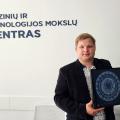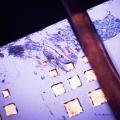Paieška
2024. 10. 07
-
V. Čižas, who is developing the next-generation of terahertz sources, becomes a PhD
Vladislovas Čižas, a physicist at the FTMC Department of Optoelectronics, becomes a PhD. He defended his thesis "Coexistence of High-Frequency Parametric and Bloch Gain in Doped GaAs/AlGaAs Superlattices" (academic supervisor: Prof. Dr. habil. Gintaras Valušis).
Congratulations to our colleague, let's keep up the good work!
This dissertation presents new sources operating in the terahertz (THz) frequency range. THz, being positioned between the visible light and microwaves, allows integration of classical optics and electronics. This capability manifests in numerous applications, including next-generation data transmission, security, pharmaceuticals, quality control, medicine, etc.
An essential part of terahertz technology is having sources to emit these electromagnetic waves. To do this, Vladislovas and his colleagues have used quantum superlattices - square-shaped derivatives made from gallium arsenide crystal, invisible to the naked eye. Thanks to their properties, the source can not only emit terahertz waves, but also amplify them by up to a thousand times!
FTMC scientists have patented the technology based on this discovery - we wrote about it in 2023.

(Square quantum superlattices and a human hair on the right. Photo: Dr. Vladislovas Čižas / FTMC)
"In this research, superlattices ability to generate high-frequency radiation has been experimentally demonstrated for the first time. The study showed that the generation is driven by coexistence of multiple mechanisms (parametric and Bloch generation), which further expands the potential uses of superlattices.
Another significant result is that, unlike classical THz sources, we were able to observe the generation of fractional sub-harmonics," says V. Čižas.

(Dissertation defence moment. Photo: FTMC)
As the use of the THz frequency range for practical applications becomes more accessible and attractive, it is hoped that the creation of small, efficient, and powerful next-generation sources will greatly reduce the cost of devices based on this technology and further expand its application possibilities.
"Most satisfying is that in the experimental part of this work, we were able to confirm long-lasting theoretical research. I believe this will revive interest in this field of research, as there is still much to be done. It is also satisfying that the theoretical modelling conducted during this dissertation supplemented a deeper understanding of the mechanisms occurring within the structure. All of this helps to set the guidelines for future research, which we will pursue in the future," says Vladislovas.
FTMC information
Susiję:

2023. 06. 02
-
FTMC team's invention is the 7000th in Lithuania
This "anniversary" is commemorated in a symbolic award.

